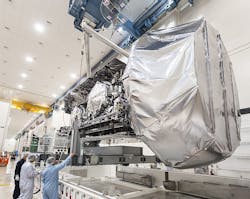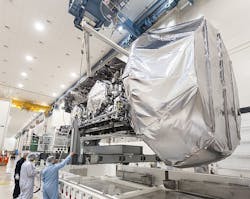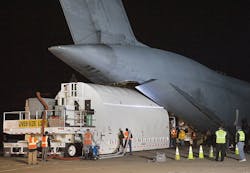U.S. Navy and Lockheed Martin deliver third MUOS secure communications satellite for mobile warfighters
SUNNYVALE, Calif., 7 Nov. 2014. The U.S. Navy and Lockheed Martin (NYSE:LMT) have delivered the third Mobile User Objective System (MUOS) spacecraft to Cape Canaveral Air Force Station, Florida, where it will be prepared for a January 2015 liftoff aboard a United Launch Alliance (ULA) Atlas V rocket.
MUOS operates like a smartphone cell tower in the sky, improving secure mobile satellite communications for warfighters on the move. For the first time, users of MUOS Wideband Code Division Multiple Access technology will have beyond-line-of-sight capability to transmit and receive voice and data using an Internet Protocol (IP)-based system.
“The delivery of MUOS-3 is an important step toward enabling our warfighters to be able to pick up the phone to seamlessly call or transfer data anywhere around the world,” says Iris Bombelyn, vice president of Narrowband Communications at Lockheed Martin. “With the launch of the third satellite in the constellation, to be followed later in 2015 by the fourth, MUOS will be in place to provide pole-to-pole and global, secure communications for the warfighter.”
MUOS-3’s safe transport to Cape Canaveral Air Force Station began from Lockheed Martin’s Sunnyvale, California, facility to nearby Moffett Federal Airfield. There, the 60th Air Mobility Wing of Travis Air Force Base loaded the satellite aboard a C-5 aircraft for final shipment on 5 Nov.
Prior to launch, Lockheed Martin engineers and technicians at the Cape will complete post shipment testing. Lockheed Martin will fuel the satellite’s propulsion system and the spacecraft will be encapsulated inside the launch vehicle’s payload fairing. The encapsulated spacecraft will then be integrated on top of an Atlas V launch vehicle for final integrated testing and closeout preparations for launch.
MUOS-2 was launched and handed over to the Navy for operations in 2013. MUOS-1 was launched and became operational in 2012. These two on-orbit MUOS satellites already are demonstrating new capabilities, especially in the Arctic, an area previously beyond the coverage of UHF satellites and growing in interest for transportation and natural resources exploration above 65 degrees north latitude. In the past year MUOS successfully connected users near the Arctic poles during independent testing by Lockheed Martin -- and their industry partners General Dynamics, Rockwell Collins, and Harris -- as well as during the U.S. Navy’s 2014 Ice Exercise (ICEX) and the U.S. Coast Guard’s Arctic Shield 2014.
Lockheed Martin Space Systems, Sunnyvale, California, is the MUOS prime contractor and system integrator. The Navy's Program Executive Office for Space Systems and its Communications Satellite Program Office, San Diego, California, are responsible for the MUOS program.


